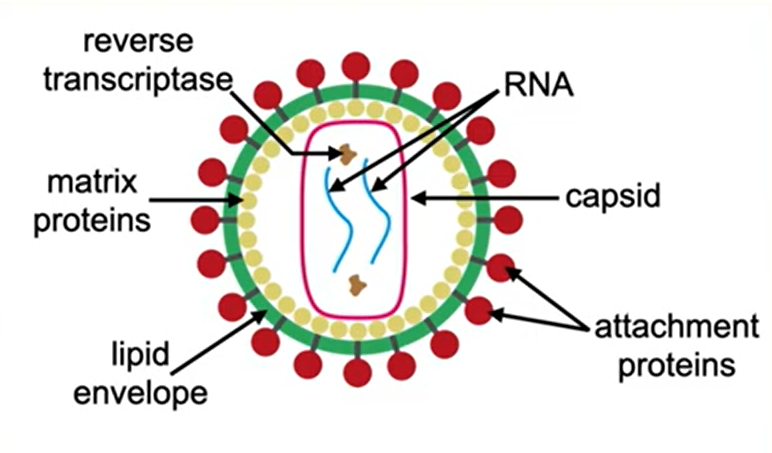2.4 (3) HIV/AIDS, antibiotics, antiviral drugs
1/25
Earn XP
Description and Tags
Name | Mastery | Learn | Test | Matching | Spaced |
|---|
No study sessions yet.
26 Terms
what does HIV stand for?
what does AIDS stand for?
Human Immunodeficiency Virus
Acquired Immunodeficiency Syndrome
what is HIV?
a retrovirus that attacks and weakens the immune system by destroying helper T-cells, which an lead to the disease AIDS if not treated
what does it mean to be ‘HIV positive’?
you are an infected person with HIV antibodies in your bloodstream
what is AIDS?
the late stage HIV infection that occurs when your immune system has been severely damaged by HIV, which leads to a number of potentially life-threatening infections and illnesses
what is a syndrome?
a group of symptoms that consistently occur together and characterise a particular abnormality or medical condition
what is the structure of HIV?
on the inside of HIV, there is a protein capsid containing:
2 RNA strands
enzymes such as reverse transcriptase and integrase.
on the outside of HIV, there is a lipid envelope with:
GP120 attachment proteins embedded on the outside
matrix proteins on the inside

what is the role of the GP120 attachment proteins?
they allow HIV to attach to its host cell and thus enter it
what is the role of matrix proteins?
they help to maintain the structure of the HIV virus
what is the role of reverse transcriptase enzymes?
allows viruses to replicate by converting viral RNA into DNA that can be integrated with the host cell’s DNA
what is the role of integrase enzymes?
allows HIV to insert/integrate its viral DNA into the DNA of the host cell
what is the role of RNA polymerase?
transcribes the viral DNA sequence into an RNA sequence
what makes HIV a retrovirus?
give another example of a retrovirus.
it’s an RNA virus (uses RNA as its genome material).
it converts RNA into DNA by reverse transcriptase.
the flu.
explain how HIV replicates in helper T-cells.
GP120 attachment proteins on HIV attach to CD4 receptors on a helper T-cell.
the lipid envelope fuses with the helper T-cell’s cell surface membrane.
the contents of the HIV’s protein coat, including RNA, pass into the helper T-cell.
once inside, reverse transcriptase converts the viral RNA into double stranded DNA.
this viral DNA moves to the helper T-cell’s nucleus and integrates with the host DNA using integrase.
the viral DNA is transcribed into HIV mRNA (transcription) using RNA polymerase.
this mRNA moves to the cytoplasm and is translated by ribososmes into viral proteins, e.g. capsid/enzymes (translation).
the viral particles assemble and bud off from the helper T-cell. they develop a viral lipid envelope derived from the host cell membrane.
the helper T-cell is destroyed/now becomes a HIV replicating cell.
how does HIV cause symptoms of AIDS?
once HIV becomes active and replicates, helper T-cells die.
as the number of helper T-cells decreases, the patient’s immune system can no longer function effectively.
this is because without enough helper T-cells, both antibody production by B-lymphocytes and cell-mediated response become less effective.
less phagocytes, B-cells and cytotoxic T cells are stimulated.
at this stage, a person is said to have AIDS (there are too few helper T-cells).
why is a person with AIDS made more vulnerable?
their immune system is ineffective/compromised.
so they cannot effectively fight off opportunistic infections such as tuberculosis and pneumonia.
and they are at a higher risk of developing cancer.
what are opportunistic infections?
infections that occur more often or are more severe in people with weakened immune systems compared to people with healthy immune systems.
people with healthy immune systems can control and destroy these infections more easily.
for people with weakened immune systems, these infections could be life-threatening.
what are antibiotics?
drugs that kill bacteria by targeting bacteria cell structures or the metabolic processes within bacteria cells.
these drugs kill bacteria without damaging body cells.
how does penicillin kill bacteria?
it prevents the cross-linking of peptidoglycan (murein) molecules in the bacteria cell wall.
this causes bacteria cells to burst when water enters by osmosis.
why are antibiotics ineffective in treating viruses like HIV?
antibiotics target bacteria cell stuctures such as the cell wall.
viruses do not have cells walls or cellular structures, so viruses are unaffected by antibiotics.
antibiotics target metabolic processes within bacteria cells.
viruses do not have their own metabolism, but instead use the metabolic process of their host cell to replicate.
so it’s difficult to target a virus without damaging/killing the host cell.
what can we use instead of antibiotics to treat viruses?
how does this treatment work?
antiviral drugs:
they can inhibit key enzymes in a virus’s replication cycle.
they can block/inactivate cell receptors to prevent attachment, so viruses can't bind to and enter healthy cells in your body.
they do not kill/remove (all) viral particles.
how can HIV be treated?
how does this treatment work?
antiretroviral therapy (ART) and the use of antiretroviral drugs against HIV.
antiretroviral drugs inhibit reverse transcriptase enzymes, to prevent HIV from replicating and prevent the development of AIDS.
this keeps levels of HIV in the bloodstream low, which reduces the impact on the host’s immune system.
what receptors on helper T-cells do HIV attachment proteins bind to?
a receptor CD4.
a coreceptor, either CCR5 or CXCR4.
HIV-1 (most common type of HIV) binds to CCR5.
true or false?
after integrating with a host cell’s DNA, the viral DNA is always active.
false - the viral DNA can either remain dormant for several years or become active and produce (m)RNA.
true or false?
HIV has several target cells.
true - HIV has several target cells (CD4 cells), but the main targets are helper T-cells because CD4 is most frequently found on them.
how can we test for HIV?
using the Enzyme-Linked Immunosorbent Assay (ELISA test), which uses antibodies to quantify the level of the HIV antigens in a blood sample
why does HIV mutate so frequently?
it has single stranded genetic material